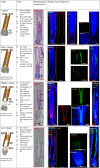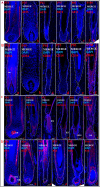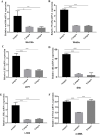A pig model exploring the postnatal hair follicle cycle
- PMID: 39391350
- PMCID: PMC11464431
- DOI: 10.3389/fcell.2024.1361485
A pig model exploring the postnatal hair follicle cycle
Abstract
Introduction: The hair follicle (HF) is a micro-organ capable of regeneration. A HF cycle consists of an anagen, catagen and telogen. Abnormalities in the HF cycle can lead to many hair disorders such as hair loss. The pig is a good biomedical model, but there are few data on their HF cycle. The aim of this study was to classify the pig HF cycle and determine the feasibility of the pig as an animal model for human HF cycle.
Methods: Skin samples from 10 different postnatal (P) days Yorkshire pigs was collected to determine the key time points of the first HF cycle in pig by H&E staining, immunofluorescence staining, q-PCR and western-blot.
Results: By morphological observation and detection of markers at different stages, pig HF cycle was classified into three main periods - the first anagen until P45, catagen (P45-P85), telogen (P85-P100), and next anagen (>P100). In addition, we examined the expression of important genes AE15, CD34, Versican, Ki67 et al. related to the HF cycle at different stages of pig HF, indicating that pig and human share similarities in morphology and marker gene expression patterns of HF cycle.
Discussion: Our findings will facilitate the study of HF cycle and offer researchers a suitable model for human hair research.
Keywords: anagen; catagen; hair follicle cycle; pig model; telogen.
Copyright © 2024 Li, Zou, Jiang, Wang and Ding.
Conflict of interest statement
The authors declare that the research was conducted in the absence of any commercial or financial relationships that could be construed as a potential conflict of interest. The author(s) declared that they were an editorial board member of Frontiers, at the time of submission. This had no impact on the peer review process and the final decision.
Figures





Similar articles
-
Atlas of Prenatal Hair Follicle Morphogenesis Using the Pig as a Model System.Front Cell Dev Biol. 2021 Oct 7;9:721979. doi: 10.3389/fcell.2021.721979. eCollection 2021. Front Cell Dev Biol. 2021. PMID: 34692680 Free PMC article.
-
The histological characteristics, age-related thickness change of skin, and expression of the HSPs in the skin during hair cycle in yak (Bos grunniens).PLoS One. 2017 May 2;12(5):e0176451. doi: 10.1371/journal.pone.0176451. eCollection 2017. PLoS One. 2017. PMID: 28463974 Free PMC article.
-
Intrinsic ROS Drive Hair Follicle Cycle Progression by Modulating DNA Damage and Repair and Subsequently Hair Follicle Apoptosis and Macrophage Polarization.Oxid Med Cell Longev. 2022 Jul 14;2022:8279269. doi: 10.1155/2022/8279269. eCollection 2022. Oxid Med Cell Longev. 2022. PMID: 35903712 Free PMC article.
-
Resting no more: re-defining telogen, the maintenance stage of the hair growth cycle.Biol Rev Camb Philos Soc. 2015 Nov;90(4):1179-96. doi: 10.1111/brv.12151. Epub 2014 Nov 19. Biol Rev Camb Philos Soc. 2015. PMID: 25410793 Free PMC article. Review.
-
Integrative and Mechanistic Approach to the Hair Growth Cycle and Hair Loss.J Clin Med. 2023 Jan 23;12(3):893. doi: 10.3390/jcm12030893. J Clin Med. 2023. PMID: 36769541 Free PMC article. Review.
References
-
- Bodo E., Tobin D. J., Kamenisch Y., Biro T., Berneburg M., Funk W., et al. (2007). Dissecting the impact of chemotherapy on the human hair follicle: a pragmatic in vitro assay for studying the pathogenesis and potential management of hair follicle dystrophy. Am. J. Pathol. 171 (4), 1153–1167. 10.2353/ajpath.2007.061164 - DOI - PMC - PubMed
LinkOut - more resources
Full Text Sources
Research Materials
Miscellaneous

